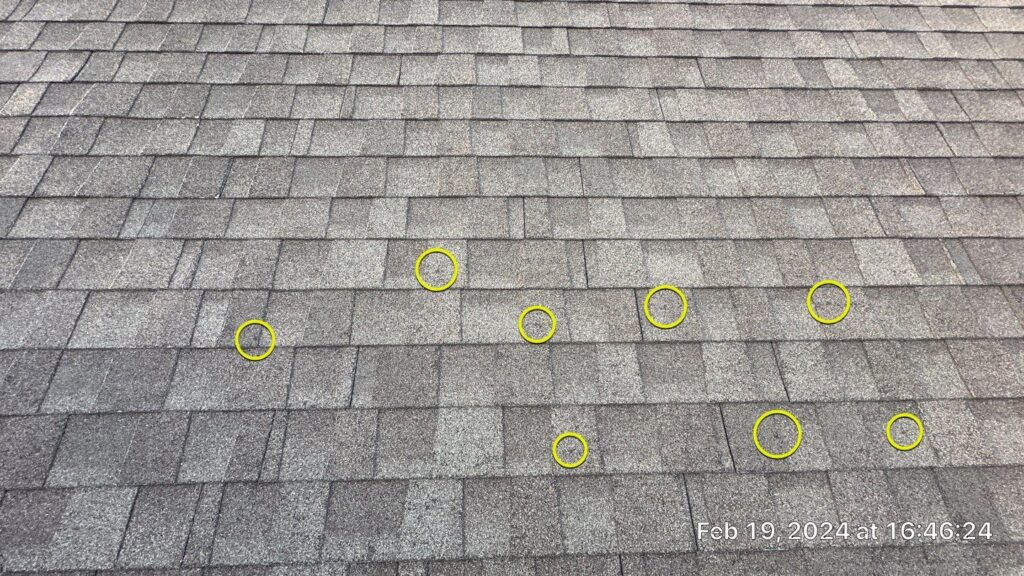Find Hail Damage On Your Roof, Siding and Other Parts Of Your Home
Do you have hail damage on your roof? How would you know?
Since becoming an adult, you may or may not be plagued by the fear of hail storms or hail damage. Hail is no joke. It can severely damage your home and your vehicle(s), which are both big investments.
It’s important to know what hail is and how to recognize its damage to your property. Thankfully, depending on your insurance coverage, items damaged by a hail storm can usually be replaced by filing a claim.
What is hail?
Hail or hailstones are solid formations of ice that fall during thunderstorms. The air movement is erratic and lifts rain water droplets into clouds which is called an updraft. The water droplets quickly freeze when they reach below freezing inside the cloud. They become ice and fall from the clouds.

Hail can come in all shapes and sizes. It’s usually seen in small pellets or ice balls, between 0.5”-1” round in diameter. However, some storms are more severe and the hail grows to much larger sizes. In Wisconsin, the record for largest hail is 5.7” wide from a storm in 2021. In the world, the largest hail ever recorded was the size of a grapefruit, measuring 8” and weighing over 2lbs.
Why is hail dangerous?
Hail damage, if hit with average size hail, isn’t immediately a problem. Once your home is hit with larger hail storms, the damage will be bigger and more problematic. The issues that follow hail damage include:
- Big or small roof leaks
- Chipped and cracked siding
- Cracked or broken windows
How to recognize hail damage on your home
Finding hail damage can be a relatively easy task. If you’ve had a recent hail storm, you will want to check these key areas of your home:
- Roof
- Gutters and downspouts
- Siding
Remember: It’s best to use a flashlight to illuminate the dents caused by hail damage.
Smaller hail will likely not cause significant enough damage to your home to be noticeable. However, the cumulative damage after several storms will definitely ruin the integrity of your home’s shingles, or dent your metal roof.
What to look for on your roof
On a roof, hail damage looks like dark spots and welts in the shingles. It’s a spot where the asphalt granules are missing, creating a vulnerable area on the roof. You can also check any vents and pipe boots on the roof, looking for welts or any broken pieces.


For metal and steel roofs, hail damage can be seen as small or large dents. Rarely will hail be strong enough to puncture a hole or crack the metal, but with continuous hail storms, the risk grows each time. Metal roofing materials are manufactured to be dent resistant, but larger hail pellets can still cause damage on ridge lines or flashings.

What to look for on your gutters and downspouts
Hail damage is easiest to spot on your home’s soft metals. Look at the home’s flashings around siding, soffit and fascia, windows and skylights, and the home’s gutters and downspouts. Even entry doors and garage doors can have dents. By using a flashlight and shining it parallel to the surface, those dents will be very visible. The downspout kick-outs are a good place to check, as they’re close to the ground and don’t require a ladder to inspect.

What to look for on your siding
Hail damage is sometimes visible on a home’s siding. Though the roof is the first to be hit with hail, the pellets can bounce or be carried by the wind to hit the siding. Hail can fully crack off small pieces of your home’s siding, which makes it very obvious to notice any existing or new hail damage.


Hail damage is easiest to spot on your home’s soft metals. Look at the home’s flashings around siding, soffit and fascia, windows and skylights. Even doors and garage doors can all have dents. By using a flashlight and shining it parallel to the surface, those dents will be very visible.

What to do if you suffer a hail storm
- Call a local contractor with experience in hail inspections
It’s important to inspect the full house and document damage with photos. If you plan to file an insurance claim, those photos will be needed as proof of damage.
- Inform your homeowner’s insurance company
- Work with the insurance adjuster and contractor to get the project completed
Meet with an ARC specialist today
It can be difficult to spot hail damage on your property. Call an ARC specialist for a hail inspection of your home. We will inspect your roof, siding, windows and doors to spot any and all signs of hail damage. Let us help you through the challenges of searching for hail damage to your home and filing an insurance claim.



